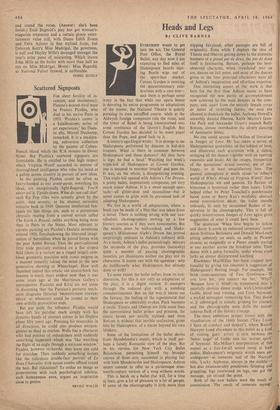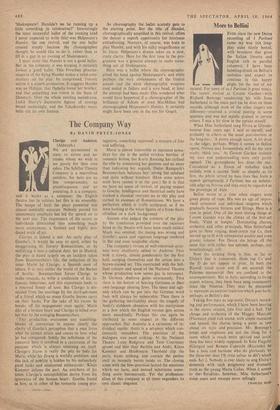Heads and Legs
By CLIVE BARNES
EVERYBODY wants to get into the act. The General Post Office, the Royal Ballet, any day now I am expecting to find sales of
Shakespeare beards oust- ing Beatle wigs out of the spare-hair market.
Covent Garden is entering
the quatercentenary cele- brations with a rare zest—
and there is perhaps some irony in the fact that while our opera house is devoting its entire programme to adaptations of the master, the National Theatre is quietly pursuing its own unruffled course. while at the Aldwych foreign companies rule the roost, and the tower of Babel is being transistorised into some semblance of the Queen's English. But Covent Garden has decided to be more papal than the Pope, and good luck to it.
A century ago Gogol wrote: 'It is strange to see Shakespeare performed by dancers in kid-skin
trousers. What is there in common between Shakespeare and these dancers? All they have is legs; he had a head.' Watching last week's triple-bill of Shakespeare at Covent Garden, one is tempted to murmur 'touché' and pass on. It was, on the whole, a disappointing evening.
This triple-bill opened with Ashton's The Dream, a pretty ballet, impressively competent, yet very much minor Ashton. It is a sweet enough spec- tacle—all glitter-dust and moonshine—but it never comes to grips with its presumed task of adapting Shakespeare.
We live in a world of adaptations, where a book can be made of a film that was taken from a novel. There is nothing wrong with our can- nibalistic choreographers stewing up a few literary sources as if they were missionaries. But the results must be well-cooked, and Shake- speare's Midsummer Night's Dream has proved surprisingly resistant to Ashton's culinary skill.
As a result, Ashton's ballet painstakingly mirrors the incidents of the play, provides (naturally) quite a number of passing choreographic beauties, yet illuminates neither the play nor its characters. It leaves one with the question: why do indifferently what Shakespeare has already done so well?
To some extent the ballet suffers from its con- densation, for this is not only an adaptation of the play, it is a digest version. It scampers through the reduced plot with a numbing conscientiousness. But on the way it leaves out the fantasy, the feeling of the supernatural that Shakespeare so admirably evokes. Puck becomes a rustic.' Titania and Oberon are little more than the conventional ballet prince and princess, the comic lovers are strictly stylised, and even Bottom is without that terrible realisation, given him by Shakespeare, of a vision beyond his own blinkers.
Some of the limitations of the ballet derive from Mendelssohn's music, which is itself per- haps a falsely Romantic view of the play. But in his version for New York City Ballet Balanchine, permitting himself the broader canvas of three acts, succeeded in playing fair with both Mendelssohn and Shakespeare. Ashton seems content to offer us a picturesque nine- teenth-century version of a song without words. This is harsh on a ballet that will, for a time as least, give a lot of pleasure to a lot of people. If some of the choreography is little more than tripping fairyland, other passages are full of originality. Even while I deplore the idea of Titania and Oberon getting down to the domestic business of a grand pas de deux, the pas de deux itself is fascinating. Bottom, perhaps the best- observed character, when 'translated' into an ass, dances on full point, and most of the dances given to the tour principal characters have all of Ashton's imagination and effortless expertise.
One interesting aspect of the work is that here for the first time Ashton seems to have recognised the new parity of accomplishment now achieved by the male dancers in the com- pany, and, apart from the entirely female corps de ballet of twinkling fairies, the men are allowed to dominate the ballet. Anthony Dowell's smoothly danced Oberon, Keith Martin's faun- like Puck and Alexander Grant's staunch Bully Bottom, almost overshadow the silvery dancing of Antoinette Sibley.
No one could accuse MacMillan of literalism in Images of Love. He has taken a series of Shakespearian quotations on the subject of love, and illustrates each criotation with a dance, stringing all the dances together with an opening ensemble and finale. All the images, irrespective of the quotations' actual context, are of un- happy, or at least unsatisfactory love. The general atmosphere is much closer to Albee's world of Who's Afraid of Virginia Woolf? than Shakespearian wit and passion. Its flavour of bitterness is hysterical rather than ironic. Little helped either by Peter Tranchell's ponderously banal score or Barry Kay's modishly abstract metal eonstrUctivist decor, the ballet unrolls tediously, lit only by occasional flashes of in- spiration in the choreography. This is full of quirky inventiveness. Images of Love again gives suggestions of what it could have been.
The quotation 'When love begins to sicken and decay It useth an enforced ceremony' intro- duces Svetlana Beriosova and Donald MacLeary sitting solemnly on seats, as sadly as Picasso clowns, as resignedly as a Pinter couple staring at one another across the breakfast table. They dance with a polite formality, under whose crust lurks an almost disinterested loathing.
Elsewhere MacMillan has been trapped into banality by giving too concrete a suggestion of Shakespeare's fleeting image. For example, the brisk cross-questions of Two Gentlemen-1f you love her, you rannot see her,' Why?' `Because love is blind'—is transmuted into a painfully obvious dance image, with Christopher Gable, blind and trusting, and Lynn Seymour, a wicked termagant tormenting him. They dance as if submerged in treacle, groping for contact, and the choreography soon dulls the instan- taneous flash of the literary concept.
The most ambitious project conies with the visualisation of the 144th Sonnet (`Two Loves I have of comfort and despair'), where Rudolf Nureyev (used elsewhere in this ballet as a kind of visiting guest artist) is torn between the `better angel' of Gable and the 'worser spirit' of Seymour. MacMillan's interpretation of this sonnet as a free-for-all sexual romp at least makes Shakespeare's enigmatic words seem un- ambiguous—as someone said of the Nureyev role, 'Lucky Alphonse, always in the middle'—' but also immeasurably ponderous. Groping and grappling, legs interwined on legs, one got the message, yet missed the point. Both of the new ballets were the result of commission. The result of someone saying:
`Shakespeare! Shouldn't we be running up a little something in celebration?' Interestingly the most successful ballet of the evening (and I never expected to write this) was Helpmann's Hamlet, the one revival, and the one ballet created simply because the choreographer thought he would like to do it, rather than to fill in a gap in an evening of Shakespeare.
I must insist that Hamlet is not a good ballet. But in the 'company it was keeping it certainly looked a good ballet. This Freudian phantas- magoria of the dying Hamlet makes a valid com- mentary on the play. Its compressed, frenetic action is a superb production. It suggests Hamlet was an cEdipus, that Ophelia loved her brother. and that something was rotten in the State of Denmark. Over the whole swirling melodrama. Leslie Hurry's decorative figures of revenge brood menacingly, and the Tchaikovsky music belts out its own fantasy. As choreography the ballet scarcely gets to the starting point. But the role of Hamlet, choreographically amplified in this revival, offers the dancer a superb opportunity for histrionic attitudinising. Nureyev, of course, was born to play Hamlet, and with his sulky magnificence as its focus, Helpmann's drama takes on a new, crazy clarity. Here for the first time in the pro- gramme was a genuine attempt to make some- thing out of Shakespeare.
Here was a ballet where the choreographer pitted his head against Shakespeare's. and while perhaps the very obviousness of the frontal assault and the weak choreographic weapons used ended in failure and a sore head, at least the attempt had been made. One wondered what would have happened if a choreographer of the brilliance of Ashton or even MacMillan had choreographed Helpmann's Hamlet. It certainly might have been one in the eye for Gogol.







































 Previous page
Previous page